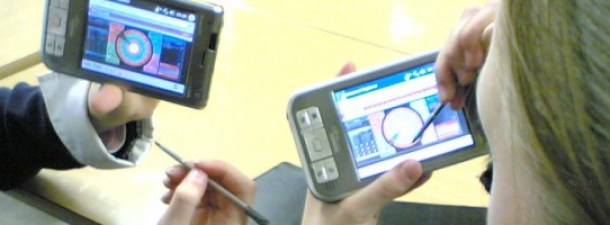By Think Big’s Miguel A. Perez, @Mangel_P
3 March 2014: Will we ever see the day when not only will kids not be forced to turn off their mobiles in class, they’ll even be encouraged to use them? Some experts in educational innovation think so, because they see mobile devices as powerful tools for teaching.
In this sense, Saint Xavier University in Chicago recently released an infographic that shows mobile technology as one of the trends that will have a significant impact on education in the coming years, along with aspects such as cloud computing, gaming and the use of open content.
In general, more and more advantages are being detected to working in the classroom with mobile devices such as tablets and smartphones, rather than limiting technology to desktop and laptop computers, because they are less expensive and require less support infrastructure.
But cost savings isn’t the only factor that could introduce mobile telephony into educational centres. At the Espacio Fundación Telefónica in Madrid on 25 January, the Director of Communications at the School of Industrial Organisation, Tíscar Lara, touted the advantages of these devices for learning, as part of one of the conferences as part of the School of Disruptive Education series.
Basically, Lara postulates that technology is a means to empower the educational community as creators. In this process, students become content creators thanks to smartphones and tablets, taking on a shared role with the teacher that before was limited exclusively to the teacher.
Mobile technology is helping to expand the classroom and the scope of learning, and also has other advantages such as: its high penetration (more than computers), which offers the possibility of establishing spontaneous multimedia communications; their ease of use and convenience, which makes them easy to carry and use in different places and at different times; and they also have an emotional and personal component that allows students to learn outside of the formal context.
The empirical research done by the EMA Research Group of the University of Barcelona on mobile learning appears to confirm the advantages of this technology.
The use of mobile phones by students to create content that is later uploaded to a website was possibly the most highly evaluated activity in the project. In this sense, the question arises as to whether learning should be an act of creation or of contemplation, which is the basis of traditional teaching.
The authors affirm that the experience with mobiles fulfilled the “4 Ps” that activities must include to hook students and improve learning:
- Placed: the developed activities corresponded to interests of the centres and the students.
- Purposeful: the proposed activities required the responsibility of each participating member and gave a purpose to the process that was carried out and the final product.
- Passion-led: the activities that were carried out increased the involvement of the students.
- Pervasive: the student body has expanded the classroom content and the final product is available to the educational community.
The project My mobile at the service of the community: learning and sharing ends with a series of ideas aimed at how to apply mobile technologies in the classroom:
- Given the enormous possibilities opened by telephones and tablets as educational tools, it is necessary to promote classroom spaces and strategies for their use.
- Students can be information creators, not merely consumers of content on the internet, and it’s is helpful to encourage them to share their work, contributions and learning online.
- Learning isn’t limited to what happens in the classroom, so creating projects that bring students into contact with the community or the nearby reality has positive results.
- Collaborative work should be taught and applied as true teamwork, and mobile communications can contribute a lot in this field.
- In general, strengthening the proposals for innovation in education with the involvement of the entire educational community (school administrators, parents and teachers) will guarantee its success.
In this sense, to finish, we can quote one of the “10 commandments of the teacher-coach” from expert Raúl González, which applies perfectly to our case: “Thou shalt not compete with the mobile phone for the attention of your students; join forces with it”.









